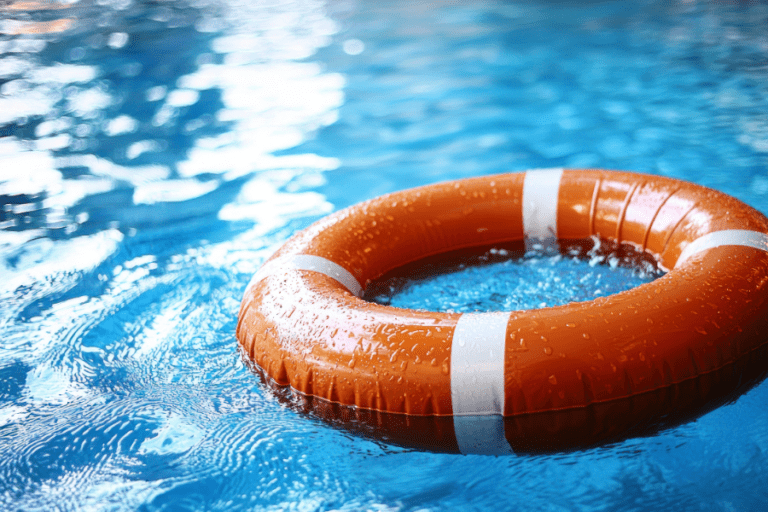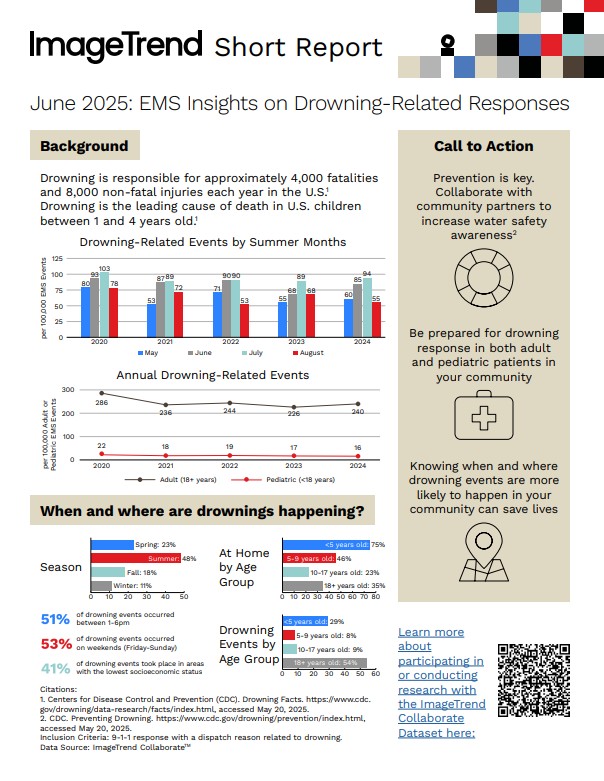By Macall Leslie Salewon, MPH, Epidemiologist
Background
Drowning remains a critical public health issue in the United States. According to the Centers for Disease Control and Prevention (CDC), approximately 4,000 people die from drowning each year, and an additional 8,000 experience non-fatal injuries. Among children aged 1 to 4 years, drowning is the leading cause of death.¹
This short report analyzes 9-1-1 EMS dispatches related to drowning, with a focus on identifying seasonal trends, timing, patient age, and incident locations, including socioeconomic factors. By understanding when and where these emergencies occur, EMS and community stakeholders can better prepare for and prevent drowning-related incidents.
Key Findings
When Are Drownings Happening?
- Summer is the peak season, with 48% of all drowning-related incidents occurring between June and August.
- Spring accounted for 23%, fall for 18%, and winter for 11% of events.
- 51% of incidents occurred between 1:00 PM and 6:00 PM—critical hours for public safety readiness.
- 53% occurred on weekends (Friday through Sunday), reinforcing the importance of resource planning during peak recreational periods.
Who Is at Risk?
- Children under 5 years old accounted for 29% of all drowning-related incidents.
- Adults aged 18 and older comprised the largest age group at 54%.
- The breakdown by age group:
- <5 years: 29%
- 5–9 years: 8%
- 10–17 years: 9%
- 18+ years: 54%
Where Are These Events Happening?
- 41% of drowning events occurred in communities with the lowest socioeconomic status—highlighting disparities in access to water safety education and supervision.
- Among children under 5 years old, 75% of incidents occurred at a home or private residence.
- Other age groups with drownings at home/private locations:
- 5–9 years: 46%
- 10–17 years: 23%
- 18+ years: 35%
These findings suggest targeted prevention strategies may be most effective when focused on residential safety for young children and community-based outreach in socioeconomically disadvantaged areas.
Call to Action
Reducing drowning-related injuries and fatalities requires more than timely EMS response—it demands proactive education, preparation, and collaboration. EMS leaders, training coordinators, and community health partners are encouraged to:
- Promote continuing education and scenario-based training for both adult and pediatric drowning response. Start with these resources:
- Pediatric Drowning Scenario Training – JEMS Training
- NAEMSP Podcast: A Silent Epidemic – Prehospital Priorities in Pediatric Drowning
- NAEMSP Podcast: Drowning Prevention is Everyone’s Responsibility
- EMS1 Article: Drowning and the Danger of Dihydrogen Oxide
- American Heart Association: Updated guidance reaffirms CPR with breaths essential for cardiac arrest following drowning
- Collaborate with local organizations—such as parks and recreation departments, public health offices, and schools—to increase community awareness around water safety, swimming supervision, and CPR training.
- Leverage your local EMS data to identify patterns in age, time, and geography. Use these insights to shape resource planning, public outreach, and seasonal readiness.
About the Data
This analysis was conducted using the ImageTrend Collaborate™ dataset, a national research resource comprised of EMS data from organizations that have opted in for data-sharing and analysis. Events were identified based on 9-1-1 EMS dispatches related to drowning.
About Collaborate
The EMS and healthcare industry is full of underutilized data which can be used to make a lasting, positive impact on the community. The ImageTrend Collaborate initiative provides insight into clinical, operational, and public health data that will contribute to healthcare provided by organizations, specific sectors, and the industry at large. Our objective is to dive into research topics relevant to the urgent topics affecting the care provided within your community.
Collaborate aggregates, de-identifies and reports on data to empower data-driven decision-making. As of 2023, Collaborate data includes over 72 million EMS activations representing all regions of the United States.
Learn more about participating in or conducting research with the ImageTrend Collaborate Dataset.
Correspondence
- ClinicalResearch@ImageTrend.com
- Clinical & Research Services ImageTrend, Inc. 1305 Corporate Center Dr, Eagan, MN 55121
Citations
- Centers for Disease Control and Prevention (CDC). Drowning Facts. https://www.cdc.gov/drowning/data-research/facts/index.html, accessed May 20, 2025.
- CDC. Preventing Drowning. https://www.cdc.gov/drowning/prevention/index.html, accessed May 20, 2025.
Related Resources

Tomorrow Won’t Look Like Today. Prepare for What’s Next.
See the bigger picture and confidently face the challenges ahead with our industry-leading solutions.




